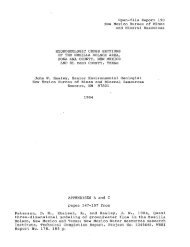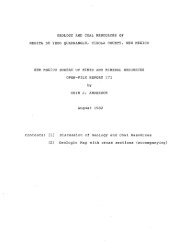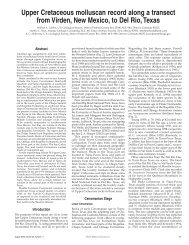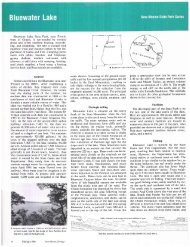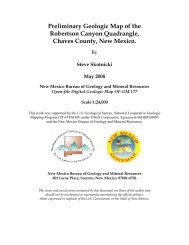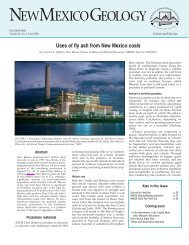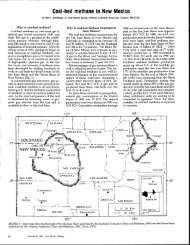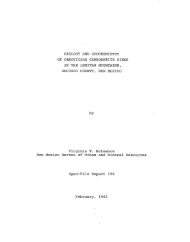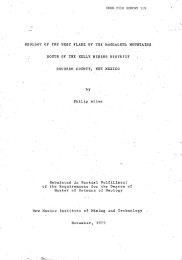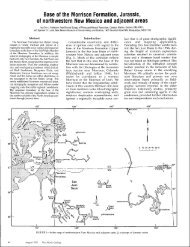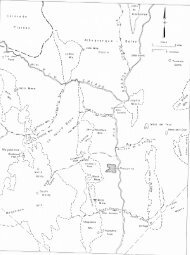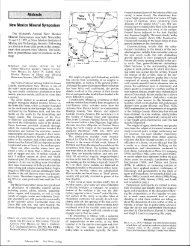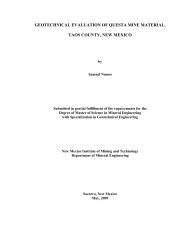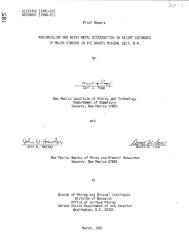Carbonatite dikes of the Chupadera Mountains, Socorro County
Carbonatite dikes of the Chupadera Mountains, Socorro County
Carbonatite dikes of the Chupadera Mountains, Socorro County
Create successful ePaper yourself
Turn your PDF publications into a flip-book with our unique Google optimized e-Paper software.
youngest pre-Tertiary intrusive rock and is<br />
<strong>Carbonatite</strong>s<br />
not metamorphosed.<br />
The carbonatites occur as a nor<strong>the</strong>asterly<br />
A thin wedge <strong>of</strong> Paleozoic limestone and trending, arcuate swarm <strong>of</strong> steeply dippin!<br />
arkose unconformably overlies <strong>the</strong> sou<strong>the</strong>rn <strong>dikes</strong> that cut <strong>the</strong> foliation <strong>of</strong> <strong>the</strong> Precam-<br />
margin <strong>of</strong> <strong>the</strong> Precambrian rocks. These sedbrian rocks. The <strong>dikes</strong> typically are exposed<br />
imentary rocks contain no carbonatite <strong>dikes</strong> within a thin, laterally extensive colluvium<br />
and are presumed to be younger. Poor ex- as rows <strong>of</strong> boulders. Wall-rock contacts are<br />
posures and major jasperoid zones make rarely observed (Fig. 3). The intrusives are<br />
identification <strong>of</strong> <strong>the</strong> Paleozoic formations un- in long, narrow zones which, in some excertain.<br />
However, Kottlowski (1950) and Egposures, contain up to three closely spaced,<br />
gleston (1982) have documented <strong>the</strong> CaloJo adjacent <strong>dikes</strong>. Individual <strong>dikes</strong> commonly<br />
(Mississippian) and Sandia (Pennsylvanian) ar6 0.2-q.9 ft thick. Select <strong>dikes</strong> have been<br />
Formations in <strong>the</strong> map area.<br />
traced continuously in outcrop for up to 200<br />
To <strong>the</strong> north and east <strong>the</strong> Precambrian rocks ft along strike. Four dike zones exceed 1,000<br />
are covered by a thick Cenozoic section <strong>of</strong> ft in shike length and may exceed 5,000 ft<br />
ash-flow tuff, felsic volcanic flows, basalt, and with only minor lateral <strong>of</strong>fset by faults. The<br />
sedimentary rocks, which compose most <strong>of</strong> extent <strong>of</strong> carbonatites concealed by Paleozoic<br />
<strong>the</strong> <strong>Chupadera</strong> <strong>Mountains</strong> (Eggleston, 1982). and younger rocks is unknown.<br />
To <strong>the</strong> west <strong>the</strong> Precambrian rocks are down- <strong>Carbonatite</strong> textures range from fine to<br />
thrown by <strong>the</strong> <strong>Chupadera</strong> fault.<br />
coarse grained and from equigranular to por-<br />
ExPlo<br />
I<br />
Alluvium I<br />
cenozoic 5onlo Fe .9<br />
broup ,:<br />
terlrory votcontc ;<br />
Josperoid<br />
Poleozoic Iimestone I L<br />
Corbonolite <strong>dikes</strong><br />
Scole<br />
o 05<br />
o I,OOO 2,OOO f t<br />
FlgUlE 2-Gene:alized geologicmap_<strong>of</strong> carbonatites in <strong>the</strong> <strong>Chupadera</strong> <strong>Mountains</strong> (precambrian rocks<br />
atter Kent, 1982; Tertiary rocks after Eggleston, I98Z; and mapping by <strong>the</strong> authors <strong>of</strong> this paper).<br />
May 1986 Nm Mexico Geology<br />
f<br />
Gronile<br />
Porphyritic schist<br />
Amphibolite ond schist<br />
Ouorlzo{eldspothic<br />
schisl ond gneiss<br />
lVico schist<br />
\<br />
o<br />
"on,o.,<br />
: side; dotted<br />
if buried<br />
strike ond dip<br />
foliotion<br />
phyritic. Many <strong>of</strong> <strong>the</strong> intrusives are microbreccias,<br />
with rounded and irregular<br />
carbonatite fragments set in a carbonatite<br />
matrix with similar composition. Phenocrysts,<br />
carbonatite fragments, and wall-rock<br />
inclusions generally align to form flow banding<br />
and local flowage segregation. Many <strong>dikes</strong><br />
are uniform in texfure, but some have variable<br />
texture along strike. Wider portions <strong>of</strong><br />
o<strong>the</strong>rs possibly are composite intrusives with<br />
sharp contacts between different phases that<br />
are distinguished by textural contrast.<br />
The carbonatites are moderate brown on<br />
fresh surfaces and yellowish brown to reddish<br />
brown where wea<strong>the</strong>red. Xenoliths and<br />
phenocrysts <strong>of</strong> magnetite, apatite, and bio-<br />
FIGURE 3-Outcrop <strong>of</strong> a 2.4-ft-thick carbonatite<br />
dike. Wall-rock coniacts are concealed by colluvlum.<br />
New AAex[c@<br />
GEOLOGY<br />
. Soience and Seruice<br />
Volume 8, No. 2, May 1946<br />
Editor: Deborah A Shaw<br />
Published quarterly by<br />
New Mexico Bureau <strong>of</strong> Mines and Mineral Resources<br />
a division <strong>of</strong> New Mqio lnstitute <strong>of</strong> Mining & Tchrology<br />
BOARD OF REGENTS<br />
Ex Officio<br />
Toney Anaya, Gooernor <strong>of</strong> Nru Mexico<br />
Alan Morgan, Superintendent ol Public lnstruclion<br />
ADDointed<br />
Steve Torres, PieZ , t967-1997, <strong>Socorro</strong><br />
Judy Floyd, Sec lTreas , 1977-7987, Ins Cruces<br />
Cilbert L Cano, 1985-1997, Albuquerque<br />
Lenton Malry, 1985-1989, Albuquerque<br />
Donald W Morris, 1983-1989, Ips Alamos<br />
New Mexico Institute <strong>of</strong> Mining & Technology<br />
Ptridffit Laurence H Lattman<br />
New Mexico Bureau <strong>of</strong> Mines & Mineral Resources<br />
Director Frank E Kottlowski<br />
Acting Deputy Director James M Robertson<br />
Subscriptions: Issued quarterly, February, May, August,<br />
November; subsqiption price $6 O0/calendar year<br />
Edttotiol mattq: Articles submitted for oublication should<br />
be in <strong>the</strong> editor's hands a minimum <strong>of</strong> five 15) months<br />
before date <strong>of</strong> publication (February, May, August, o!<br />
Novenber) and should be no longer than 20 typewritten,<br />
double-spaced pages. All scientific pape$ will be<br />
reviewed by at least two people in <strong>the</strong> appropriate field<br />
<strong>of</strong> study Address inquiries to Deborah A Shaw, Editor<br />
ot Nru Mexico Geology, New Mexico Bureau <strong>of</strong> Mines &<br />
Mineral Resources, <strong>Socorro</strong>, NM 87801<br />
Published. as public domain, <strong>the</strong>relore reproducible without per<br />
fr5sion. Source credit rcquested<br />
Circuletion: 1 ,600<br />
Prinler University <strong>of</strong> New Mexico Printing Plant



